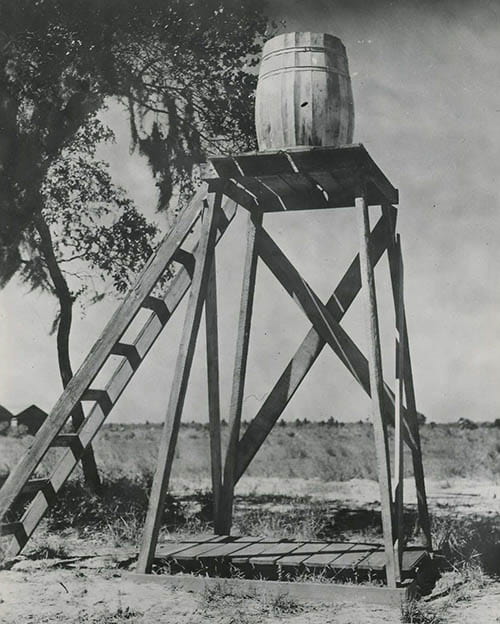One of the best uses for harvested rainwater is an outdoor shower. You’ll be able to clean off garden debris and other dirt so it doesn’t enter your home.
While making an outdoor rainwater shower is fairly simple, there are things you need to know first – like how to keep the water clean, legal requirements, and whether you’ll need a permit.
Are Rainwater Showers Safe?
It is completely safe to use rainwater for showering and bathing. Many people actually prefer it because rainwater is soft and does not have chlorine in it, thus making it better for skin and hair.
However, if rainwater is left stagnant in barrels, it can develop algae. While this isn’t necessarily harmful, it is certainly unpleasant to shower with smelly green water.
Treating Rainwater for Showering
A good rainwater harvesting system should include pre-treatment methods to keep leaves and debris out of the collected water. These include gutter screens, first flush diverters, screens over barrel inlets and filters.
So long as the rainwater is used fairly quickly, it should remain clean. However, if the rainwater in your containers must sit for longer periods of time, you might want to treat it with bleach.
To treat water in your rain barrels with bleach:
- Use only unscented bleach with no other additives
- The bleach should be 5-6% strength
- Add 1/8 teaspoon (8 drops) per 1 gallon of water
- Wait approximately 24 hours before using the treated water
Are Rainwater Showers Legal?
Rainwater showers are usually legal. However, some states do have laws that only allow rainwater to be used for irrigation.
In these cases, it may still be legal to use a rainwater shower but you’d have to meet stricter standards for water quality and plumbing.
Do I Need a Permit for a Rainwater Shower?
You usually will not need a permit for a simple outdoor rainwater shower. These are usually exempt from building, zoning and plumbing code requirements as well.
However, you may need a permit and to meet codes if your rainwater shower has a permanent structure, drains, or hot water connections.
You’ll still have to check with your county or city as the rules vary depending on where you live.
How to Set Up a Simple Outdoor Rainwater Shower
There are a lot of different ways to set up a rainwater shower outdoors. Here are the basic instructions.
1. Decide whether you want a gravity or pump-powered shower?
Gravity-powered rainwater showers work by hanging the tank overhead. Because there are no moving components, they are cheap and easy to maintain.
The downsides of gravity showers are that they lose pressure as they empty and can also be very heavy, thus difficult to hang.
With pump-powered rainwater showers, a pump brings the water from the tank to the showerhead. They range from cheap battery or foot-powered pumps to more complex electric pumps with high pressure.
While more expensive than a gravity shower, the pump means you don’t have to deal with lifting heavy shower tanks overhead.

2. Choose where you will put the rainwater shower
Drainage is one of the main considerations when choosing where to put a rainwater shower. Building codes in some areas don’t allow you to have outdoor showers which drain into streams or places which will create a “nuisance.”
With gravity rainwater showers, you’ll need to have a strong structure nearby (like a tree with sturdy branches) for hanging the shower tank. Pump-powered showers can be located almost anywhere but keep in mind that pressure decreases with distance from the tank.

3. Create a platform
You don’t want the rainwater from the shower to fall directly on the ground as it will create a muddy mess below your feet. Instead, you’ll want to create a platform with good drainage. A simple and cheap way to do this is to:
- Put a layer of round stones on the ground
- Set a wood platform with slats in it above the rocks
4. Create a privacy screen
You can buy privacy screens for camping (like this one) that will work for rainwater showers too.
It’s also fairly easy to make your own. Just make a structure out of PVC pipes and elbow fittings then hang a shower curtain from the structure you created.
5. Choose your shower reservoir and head
While it is possible to pump water directly from your rainwater harvesting barrels for showering, it often isn’t practical. You’ll be limited to where you can put the shower and (unless your rain barrels are elevated) you will need to use a pump.
Instead, it makes more sense to put the rainwater into a separate reservoir. For example, you could use the spigot on your rain barrel to fill up a camping solar shower.
Because the shower water tank is separate from the main rainwater tank, it is more portable. The water also heats up faster in a small tank.
There are many rainwater shower reservoirs to choose from. They range from simple camping-type showers to showers with built-in heaters and adjustable pressure heads.
Advanced Elements 5 Gallon Summer Shower
This solar shower is an example of a gravity-powered shower. After filling, you simply hang the shower overhead.
Ivation Portable Outdoor Shower
This cheap battery-powered camping shower has a built-in pump so you can shower with water from buckets.

Check On Amazon
For more, see our picks for the best off-grid showers.
https://sonomacounty.ca.gov/PRMD/TechBulletin/Plumbing/P-05-2020-Residential-Outdoor-Showers-and-Sinks/
https://njaes.rutgers.edu/fs1218/
https://web.extension.illinois.edu/askextension/thisQuestion.cfm?ThreadID=22724&catID=179&AskSiteID=84




